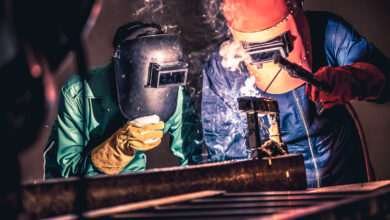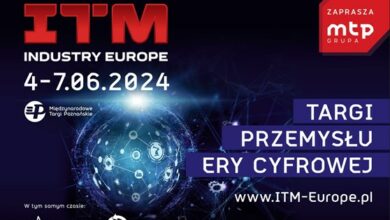Plasma welding on welding robots
Plasma welding on welding robots is a technology that uses a plasma stream to melt and join metals. Plasma is an ionized gas characterized by very high temperature and electrical conductivity. The robot is equipped with a welding head that contains a tungsten electrode and a plasma nozzle. The tungsten electrode is heated and generates an electric arc, which is focused by the plasma nozzle. As a result, a plasma stream with a very high temperature is created, melting the welded material.
Advantages of plasma welding:
- The speed and precision of the welding process. The automation of the process guarantees high accuracy and repeatability. The efficiency of welding robots significantly accelerates the pace of production.
- High efficiency and accuracy of welding. Plasma welding allows for achieving a very narrow weld with high quality.
- The ability to weld various materials. Plasma welding can be used to weld many different materials, including steel, aluminum, copper, and titanium.
- The ability to weld thin materials. Plasma welding enables the welding of materials with a thickness of even a few millimeters.
- High resistance to corrosion. Welds made by the plasma method are characterized by good mechanical properties, such as strength, impact resistance, and corrosion resistance.
- Welding of elements with complex shapes. Plasma welding allows for the welding of elements with complex shapes, without the risk of overheating or damaging the material. This is important in cases of welding elements that must be made with great precision.
Plasma welding is used in many different industries, such as:
- Construction
- Mechanical engineering
- Automobiles and transportation
- Aerospace
- Energy
Plasma welding is a modern and efficient method of joining metals, offering many benefits. If you are looking for a welding method that provides high quality, efficiency, and accuracy, then plasma welding is an excellent choice.
TIG Machine Welding
TIG welding, also known as tungsten inert gas (GTAW) welding, is a method of welding using a non-consumable tungsten electrode in the shield of an inert gas such as argon or helium. The tungsten electrode does not melt during welding but generates an electric arc that melts the welded material. The inert gas surrounding the arc protects it from oxidation.
The advantages of TIG welding are:
- High quality of welds. Welds made using the TIG method are characterized by high strength, ductility, and resistance to corrosion.
- Precision of welding. TIG welding allows for very precise welds. It is an ideal solution for welding thin sheets and small-sized details without the risk of burn-through.
- Ability to weld different materials. TIG welding can be used to simultaneously join many different materials, including steel, aluminum, copper, and titanium.
- Welding of complex-shaped elements. TIG welding enables the welding of elements with complex shapes, without the risk of overheating or damaging the material. This is important in cases where elements must be made with high precision.
TIG welding is an excellent choice for joining elements that need to be made from different materials to ensure optimal technical properties. Thanks to the control of heat during the TIG welding process, the distortion of the material is minimized, resulting in high quality of the manufactured element.
Welding on a MIG/MAG Machine
MIG/MAG welding, also known as Gas Metal Arc Welding (GMAW), is a welding method where the consumable electrode is a wire fed continuously. The electric arc generated between the electrode and the material being welded melts the wire and the material to be welded, creating a weld. The shielding gas surrounding the arc protects it from oxidation.
The advantages of MIG/MAG welding at Spartherm are:
- High efficiency. MIG/MAG welding allows for high welding speeds, making it a particularly efficient method for large components.
- Versatility. MIG/MAG welding can be used to join different materials, including steel, aluminum, copper, and titanium.
- Welding of large components. It is an ideal method for welding large components such as steel structures or machine parts.
- Welding thin materials. Enables welding of materials with a thickness of even a few millimeters, without the risk of burn-through.
- Welding complex-shaped elements. MIG/MAG welding allows for the welding of elements with complex shapes, without the risk of overheating or damaging the material.
- Precision. Allows for achieving precise welds, even in hard-to-reach places.
At Spartherm, we have 7 MIG and MAG welding machines at our disposal, allowing us to quickly and accurately complete the tasks entrusted to us with minimal production costs. Thanks to our experienced specialists and modern equipment, we can meet the most demanding projects, delivering welding solutions at the highest level.
Conventional Welding
Conventional welding is a general term for welding methods that use an electric arc to melt the welded metal. Depending on the type of welding electrode used, the following conventional welding methods are distinguished:
- Shielded Metal Arc Welding (MMA) – The coated electrode is made of wire wrapped with flux. The electric arc generated between the electrode and the material being welded melts the wire and the welded material, creating a weld. The flux surrounding the electrode protects the arc from oxidation and forms slag, which must be removed after welding is completed.
- Gas Tungsten Arc Welding (GTAW) – The tungsten electrode does not melt during welding but produces an electric arc that melts the welded material. An inert gas surrounding the arc protects it from oxidation.
- Metal Inert Gas / Metal Active Gas Welding (MIG/MAG) – The consumable electrode is a wire fed continuously. The electric arc generated between the electrode and the material being welded melts the wire and the welded material, creating a weld. The shielding gas surrounding the arc protects it from oxidation.
The advantages of conventional welding are:
- Versatility – Conventional welding methods can be used for welding various materials.
- Precision – Conventional welding allows for achieving precise welds, even in hard-to-reach places.
- Reduced equipment complexity – which translates into lower costs for the customer.
- Multitasking – the ability to manually control the welding process, which facilitates work in non-standard conditions.
Choose Professionals for Collaboration
It’s advisable to entrust welding services to professionals because, with their experience and specialized knowledge, you will receive high-quality connections that are durable and safe. They have advanced equipment, which ensures precision and efficiency, even in the case of the most demanding projects.


